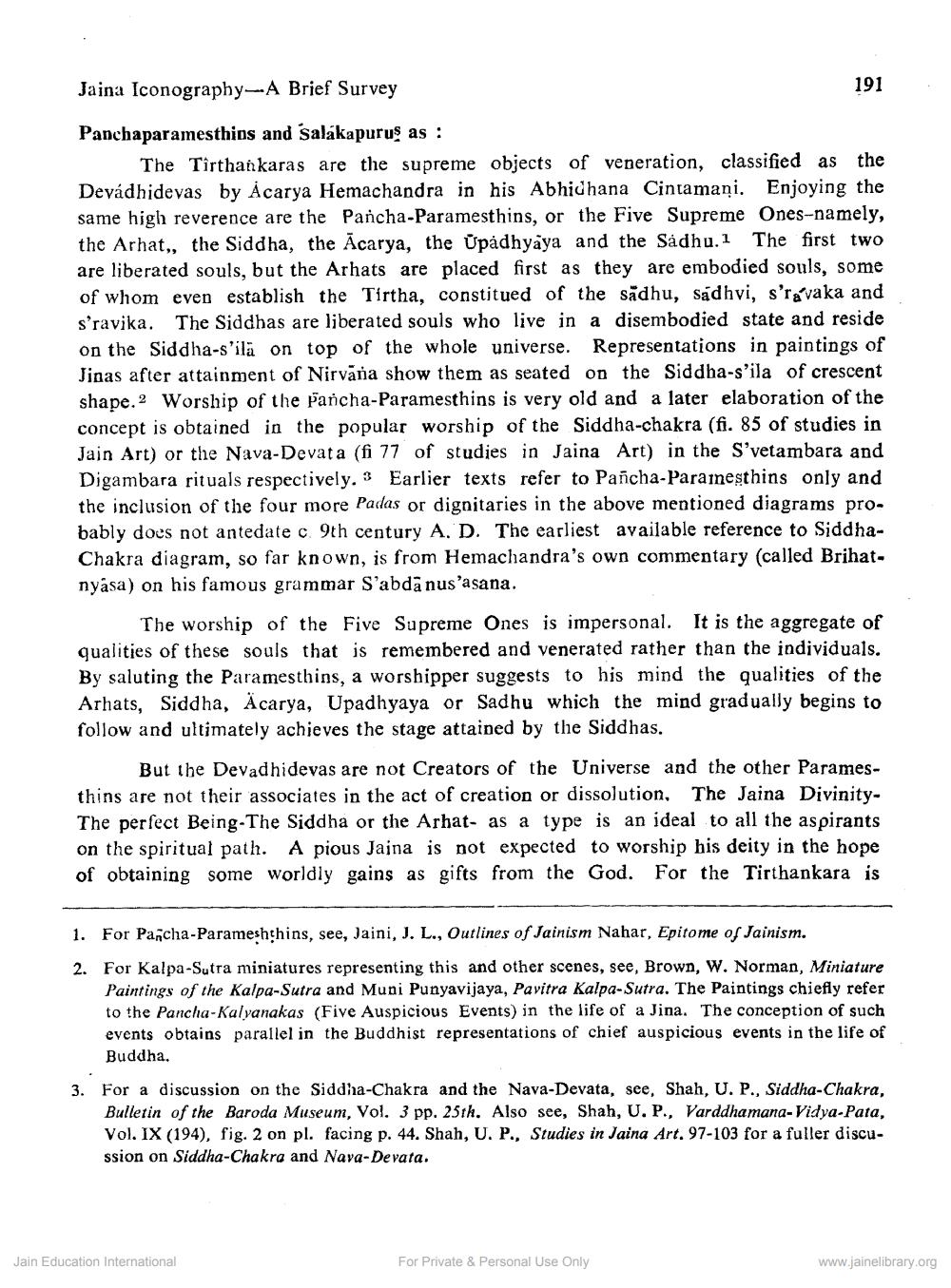________________
Jaina Iconography- A Brief Survey
191
Panchaparamesthips and salákapurus as :
The Tîrthankaras are the supreme objects of veneration, classified as the Devádhidevas by Acarya Hemachandra in his Abhidhana Cintamani. Enjoying the same high reverence are the Pancha-Paramesthins, or the Five Supreme Ones-namely, the Arhat,, the Siddha, the Acarya, the Upadhyaya and the Sadhu.1 The first two are liberated souls, but the Arhats are placed first as they are embodied souls, some of whom even establish the Tirtha, constitued of the sadhu, sadhvi, s'ra vaka and s'ravika. The Siddhas are liberated souls who live in a disembodied state and reside on the Siddha-s'ilä on top of the whole universe. Representations in paintings of Jinas after attainment of Nirvana show them as seated on the Siddha-s'ila of crescent shape.2 Worship of the Pancha-Paramesthins is very old and a later elaboration of the concept is obtained in the popular worship of the Siddha-chakra (fi. 85 of studies in Jain Art) or the Nava-Devata (fi 77 of studies in Jaina Art) in the S'vetambara and Digambara rituals respectively. 3 Earlier texts refer to Pancha-Paramesthins only and the inclusion of the four more Padas or dignitaries in the above mentioned diagrams probably does not antedate c 9th century A. D. The earliest available reference to SiddhaChakra diagram, so far known, is from Hemachandra's own commentary (called Brihatnyása) on his famous grammar S'abda nus’asana.
The worship of the Five Supreme Ones is impersonal. It is the aggregate of qualities of these souls that is remembered and venerated rather than the individuals. By saluting the Paramesthins, a worshipper suggests to his mind the qualities of the Arhats, Siddha, Acarya, Upadhyaya or Sadhu which the mind gradually begins to follow and ultimately achieves the stage attained by the Siddhas.
But the Devadhidevas are not Creators of the Universe and the other Paramesthins are not their associates in the act of creation or dissolution, The Jaina DivinityThe perfect Being-The Siddha or the Arhat- as a type is an ideal to all the aspirants on the spiritual path. A pious Jajna is not expected to worship his deity in the hope of obtaining some worldly gains as gifts from the God. For the Tirthankara is
1. For Pancha-Parameshthins, see, Jaini, J. L., Outlines of Jainism Nahar, Epitome of Jainism. 2. For Kalpa-Sutra miniatures representing this and other scenes, see, Brown, W. Norman, Miniature
Paintings of the Kalpa-Sutra and Muni Punyavijaya, Pavitra Kalpa-Sutra. The Paintings chiefly refer to the Pancha-Kalyanakas (Five Auspicious Events) in the life of a Jina. The conception of such events obtains parallel in the Buddhist representations of chief auspicious events in the life of Buddha.
3. For a discussion on the Siddha-Chakra and the Nava-Devata, see, Shah, U. P., Siddha-Chakra,
Bulletin of the Baroda Museum, Vol. 3 pp. 25th. Also see, Shah, U. P., Varddhamana-Vidya-Pata, Vol. IX (194), fig. 2 on pl. facing p. 44. Shah, U. P., Studies in Jaina Art. 97-103 for a fuller discussion on Siddha-Chakra and Nava-Devata.
Jain Education International
For Private & Personal Use Only
www.jainelibrary.org




